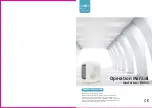
46
IM 738-2
Mechanical Installation:
Steam Coil Piping
Steam Piping Recommendations
1
Be certain that adequate piping flexibility is provided.
Stresses resulting from expansion of closely coupled piping
and coil arrangement can cause serious damage.
2
Do not reduce pipe size at the coil return connection. Carry
return connection size through the dirt pocket, making the
reduction at the branch leading to the trap.
3
Install vacuum breakers on all applications to prevent
retaining condensate in the coil. Generally, the vacuum
breaker is to be connected between the coil inlet and the
return main. However, if the system has a flooded return
main, the vacuum breaker to the atmosphere; the trap
design should allow venting of the large quantities of air.
4
Do not drain steam mains or takeoffs through coils. Drain
mains ahead of coils through a steam trap to the return line.
5
Do not attempt to lift condensate.
6
Pitch all supply and return steam piping down a minimum
of 1" (25 mm) per 10 feet (3 m) of direction of flow.
Steam Trap Recommendations
1
Size traps in accordance with manufacturers’
recommendations. Be certain that the required pressure
differential will always be available. Do not undersize.
2
Float and thermostatic or bucket traps are recommended for
low pressure steam. Use bucket traps on systems with on-
off control only.
3
Locate traps at least 12" (305 mm) below the coil return
connection.
4
Always install strainers as close as possible to the inlet side
of the trap.
5
A single tap may generally be used for coils piped in
parallel, but an individual trap for each coil is preferred.
Steam Coil Freeze Conditions
If the air entering the steam coil is below 35°F (2°C), note the
following recommendations:
1
Supply 5 psi (34.5 kPa) steam to coils at all times.
2
Modulating valves are not recommended. Control should
be by means of face and bypass dampers.
3
As additional protection against freeze-up, install the tap
sufficiently far below the coil to provide an adequate
hydrostatic head to ensure removal of condensate during an
interruption on the steam pressure. Estimate 3 ft. (914 mm)
for each 1 psi (7 kPa) of trap differential required.
4
If the unit is to be operated in environments with possible
freezing temperatures, an optional freezestat is
recommended. See “Freeze Protection” on page 91 for
additional information.
Figure 55. Valve assembly
Figure 56. Steam valve package
S t e m
S e t s c r e w s
S t e m l i p
R e t u r n
S u p p l y
















































